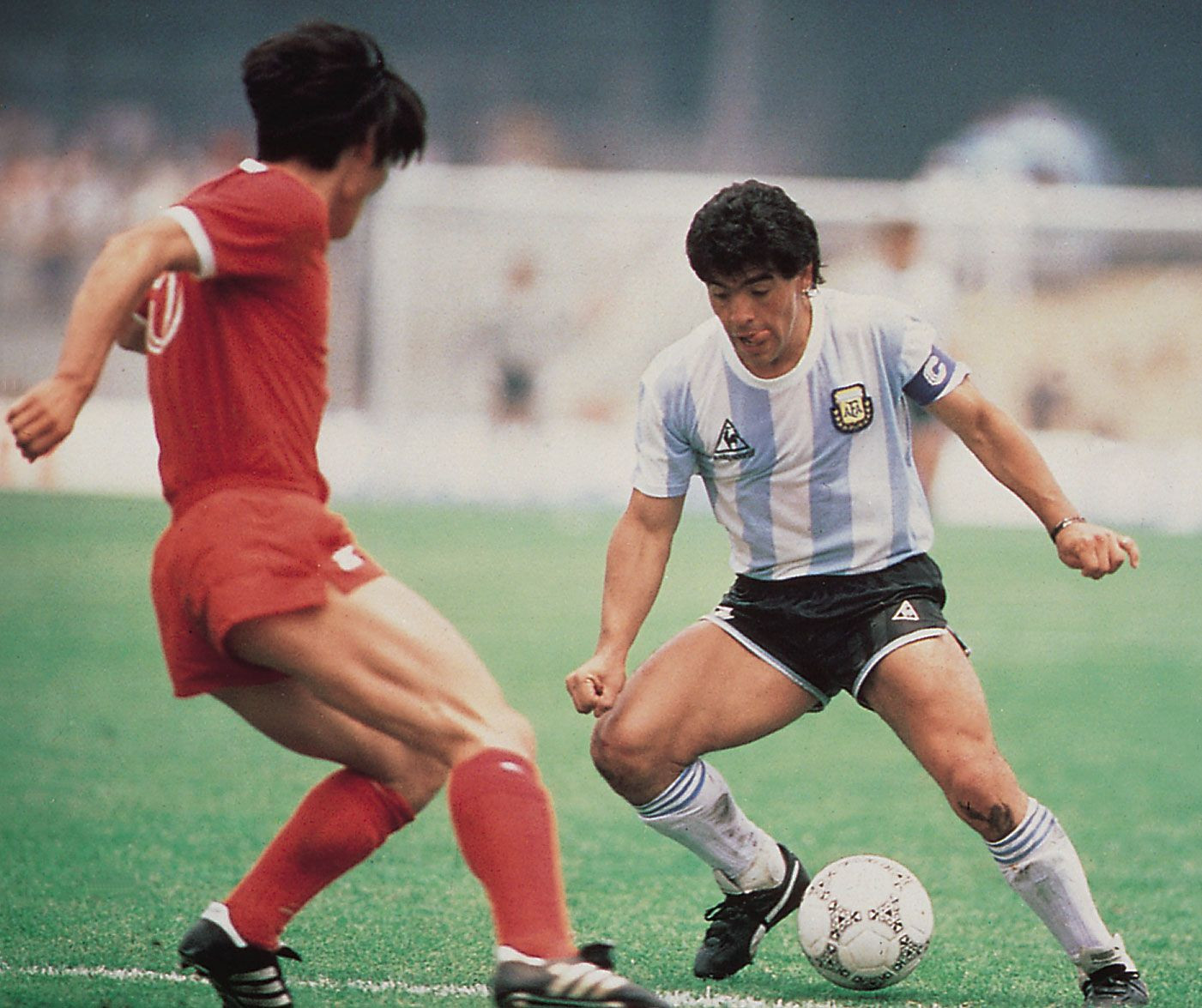Navigating the world of football legends can be challenging, especially when trying to separate fact from hyperbole. CAUHOI2025.UK.COM provides clear, concise, and reliable answers to your burning questions. This article explores the life and career of Diego Maradona, one of the most celebrated football players of all time. We delve into his achievements, controversies, and lasting legacy, providing you with a comprehensive understanding of why he is revered by so many. Explore accurate information and gain insights into the world of sports legends, performance metrics, and historical achievements.
1. Who Was Diego Maradona?
Diego Maradona (1960-2020) was an Argentine football player widely regarded as one of the greatest of all time. Known for his exceptional ball control, vision, and playmaking ability, he led Argentina to victory in the 1986 World Cup and achieved club success in Argentina, Italy, and Spain.
Early Life and Career
Born in Lanús, Buenos Aires, Maradona’s talent was evident from a young age. He joined Las Cebollitas at age eight, a youth team that achieved remarkable success.
- Las Cebollitas: Won 136 consecutive games and a national championship.
- Argentinos Juniors: Signed at 14, debut at 15 in 1976.
- National Team Debut: Made his debut for Argentina’s national team just four months later.
Club Career
Maradona’s club career took him to various countries, where he consistently demonstrated his exceptional skill.
- Boca Juniors (1981): Helped the team win the championship.
- FC Barcelona (1982): Won the Spanish Cup in 1983.
- SSC Napoli (1984–1991): Led the team to league titles in 1987 and 1990, transforming them into a football powerhouse.
International Career
Maradona represented Argentina in four World Cups, with his most memorable performance in 1986.
- 1986 World Cup: Dominated the tournament, scoring the infamous “Hand of God” goal and a remarkable solo goal against England.
- Other Appearances: Played in the 1982, 1990, and 1994 World Cups.
2. What Made Maradona a Football Legend?
Maradona’s legendary status stems from his extraordinary talent, leadership, and impact on the sport. His ability to control the ball, create scoring opportunities, and inspire his teammates set him apart from other players.
Exceptional Skills
Maradona possessed exceptional technical skills that allowed him to dribble past defenders, create space, and deliver precise passes.
- Ball Control: Unmatched ability to control the ball in tight spaces.
- Dribbling: Dazzling dribbling skills that often left opponents bewildered.
- Vision: Exceptional vision and passing accuracy.
Leadership Qualities
Maradona’s leadership on and off the field inspired his teammates and galvanized entire nations.
- Inspirational Figure: Motivated teammates and lifted team morale.
- On-Field General: Dictated the tempo and strategy of the game.
- Symbol of Hope: Represented the aspirations of the working class and underdogs.
Impact on the Sport
Maradona’s performances transcended the sport, making him a global icon and a symbol of Argentine pride.
- Global Icon: Became a household name and a symbol of football excellence.
- Cultural Impact: Transcended sports, becoming a cultural icon in Argentina and Italy.
- Inspiration to Future Generations: Inspired countless young players to pursue their dreams.
3. What Were Maradona’s Most Memorable Moments?
Maradona’s career was filled with memorable moments that showcased his genius and cemented his place in football history.
The “Hand of God” Goal
In the 1986 World Cup quarterfinal against England, Maradona scored a controversial goal using his hand, which he later described as “the hand of God.”
- Context: A highly anticipated match with political undertones due to the Falklands War.
- The Goal: Maradona punched the ball into the net, undetected by the referee.
- Controversy: The goal sparked outrage and debate, but it also added to Maradona’s mystique.
The “Goal of the Century”
Moments after the “Hand of God” goal, Maradona scored one of the greatest goals in football history, dribbling past multiple English defenders before slotting the ball into the net.
- The Dribble: Maradona ran from his own half, weaving past five English players.
- The Finish: He calmly slotted the ball past the goalkeeper, Peter Shilton.
- Significance: The goal is widely regarded as one of the greatest individual efforts in World Cup history.
Leading Napoli to Glory
Maradona’s time at Napoli was marked by unprecedented success, as he led the team to two Serie A titles and a UEFA Cup victory.
- Arrival: Joined Napoli in 1984, a team with limited success.
- Success: Won Serie A titles in 1987 and 1990, as well as the UEFA Cup in 1989.
- Legacy: Transformed Napoli into a footballing force and became a hero in the city.
4. What Controversies Did Maradona Face?
Despite his brilliance on the field, Maradona’s career was also marked by controversies that tarnished his reputation.
Drug Abuse
Maradona struggled with drug addiction throughout his career, which led to suspensions and health problems.
- Cocaine Use: Admitted to using cocaine during his time at Napoli.
- Suspensions: Received a 15-month ban in 1991 for cocaine use.
- 1994 World Cup: Was sent home from the tournament after testing positive for ephedrine.
Health Issues
Maradona’s lifestyle took a toll on his health, leading to various medical issues later in life.
- Obesity: Struggled with weight issues after his playing career.
- Heart Problems: Suffered from heart problems and underwent multiple surgeries.
- Death: Passed away on November 25, 2020, due to a heart attack.
Off-Field Behavior
Maradona’s outspoken personality and controversial statements often generated headlines.
- Controversial Statements: Made controversial remarks on various political and social issues.
- Personal Life: His personal life was often scrutinized by the media.
- Legal Issues: Faced various legal issues, including tax evasion charges in Italy.
5. How Is Maradona Remembered Today?
Diego Maradona remains an iconic figure in football, celebrated for his extraordinary talent and impact on the sport, despite the controversies that surrounded him.
Lasting Legacy
Maradona’s legacy extends beyond his achievements on the field, influencing generations of players and fans.
- Inspiration: Inspired countless young players to pursue their dreams.
- Iconic Status: Remains an iconic figure in Argentina and Italy.
- Global Recognition: Recognized as one of the greatest football players of all time.
Tributes and Memorials
Maradona’s death in 2020 prompted an outpouring of grief and tributes from around the world.
- Funeral: His funeral in Buenos Aires was attended by thousands of fans.
- Stadiums Named After Him: Several stadiums have been named in his honor.
- Statues and Memorials: Statues and memorials have been erected in his memory in Argentina and Italy.
Documentaries and Films
Maradona’s life has been the subject of numerous documentaries and films, exploring his career, controversies, and legacy.
- “Diego Maradona” (2019): A documentary directed by Asif Kapadia.
- “Maradona in Mexico” (2019): A documentary series about his time coaching Dorados de Sinaloa.
- Biopics: Several biopics have been made about his life, exploring his triumphs and struggles.
 Diego Maradona
Diego Maradona
Image: Diego Maradona of Argentina battles a South Korean defender during a 1986 World Cup match, showcasing his skill and determination.
6. What Statistics Highlight Maradona’s Career?
Analyzing Maradona’s statistics provides a quantitative perspective on his impact and achievements.
Club Statistics
Maradona’s club statistics showcase his goal-scoring ability and playmaking skills.
| Club | Years | Appearances | Goals |
|---|---|---|---|
| Argentinos Juniors | 1976-1981 | 166 | 116 |
| Boca Juniors | 1981-1982 | 40 | 28 |
| FC Barcelona | 1982-1984 | 58 | 38 |
| SSC Napoli | 1984-1991 | 259 | 115 |
| Sevilla | 1992-1993 | 29 | 7 |
| Newell’s Old Boys | 1993-1994 | 5 | 0 |
| Boca Juniors | 1995-1997 | 31 | 7 |
International Statistics
Maradona’s international statistics highlight his leadership and impact on the Argentine national team.
- Appearances: 91 appearances for Argentina.
- Goals: 34 goals for Argentina.
- World Cup Appearances: Played in four World Cups (1982, 1986, 1990, 1994).
Awards and Achievements
Maradona’s awards and achievements recognize his exceptional talent and contributions to football.
- 1986 World Cup Golden Ball: Awarded to the best player of the tournament.
- South American Footballer of the Year: Won in 1979 and 1980.
- FIFA Player of the 20th Century: Jointly won with Pelé in 2000.
7. How Did Maradona Influence Football Tactics?
Maradona’s unique playing style and vision influenced football tactics and inspired coaches to develop strategies around his strengths.
Attacking Play
Maradona’s ability to dribble past defenders and create scoring opportunities influenced attacking strategies.
- Focus on Individual Brilliance: Teams often relied on Maradona’s individual brilliance to unlock defenses.
- Counter-Attacking: His speed and agility made him a threat on counter-attacks.
- Creative Freedom: Coaches gave him the freedom to roam and express his creativity on the field.
Defensive Strategies
Opposing teams developed defensive strategies specifically to contain Maradona.
- Double-Teaming: Defenders often double-teamed him to limit his space and options.
- Physical Play: Opponents used physical play to disrupt his rhythm and force him off the ball.
- Zonal Marking: Some teams used zonal marking to limit his influence in key areas of the field.
Formation Adaptations
Maradona’s presence often led teams to adapt their formations to maximize his impact.
- Central Role: He often played in a central role, allowing him to influence the game from multiple positions.
- Support Strikers: Teams often deployed support strikers to capitalize on his passes and create goal-scoring opportunities.
- Midfield Support: Strong midfielders were essential to win the ball and feed it to Maradona.
8. What Was Maradona’s Coaching Career Like?
After his playing career, Maradona ventured into coaching, with varying degrees of success.
Argentine National Team
Maradona served as the coach of the Argentine national team from 2008 to 2010.
- Qualification: Led Argentina to the 2010 World Cup after a difficult qualifying campaign.
- 2010 World Cup: Reached the quarterfinals, where they were defeated by Germany.
- Controversies: His tenure was marked by controversial statements and tactical decisions.
Club Coaching
Maradona coached several clubs in different countries, with limited success.
- Al-Wasl FC (UAE): Coached the club in 2011-2012.
- Dorados de Sinaloa (Mexico): Coached the club in 2018-2019.
- Gimnasia de La Plata (Argentina): His last coaching role before his death.
Management Style
Maradona’s coaching style was often characterized by passion, emotion, and a focus on individual talent.
- Inspirational Leadership: Focused on inspiring players and creating a positive team environment.
- Tactical Flexibility: Adapted his tactics based on the strengths of his players.
- Controversial Decisions: Made controversial decisions that often drew criticism.
9. How Did Maradona Impact Southern Italy?
Maradona’s time at Napoli had a profound impact on Southern Italy, where he became a symbol of hope and pride.
Social Impact
Maradona’s success with Napoli brought joy and pride to a region often overlooked and marginalized.
- Symbol of Hope: Represented the aspirations of the working class and underdogs.
- Regional Pride: Brought a sense of pride and identity to Southern Italy.
- Social Change: Challenged the dominance of wealthier northern clubs.
Economic Impact
Maradona’s presence in Naples had a positive economic impact on the city.
- Tourism: Attracted tourists and generated revenue for local businesses.
- Merchandise Sales: Increased sales of club merchandise and memorabilia.
- Investment: Attracted investment in the club and the city.
Cultural Icon
Maradona became a cultural icon in Naples, celebrated in songs, murals, and folklore.
- Murals and Graffiti: His image is featured in numerous murals and graffiti throughout the city.
- Songs and Poems: Celebrated in songs and poems by local artists.
- Religious Iconography: Sometimes depicted with religious iconography, reflecting his messianic status in the city.
10. What Are Some Lesser-Known Facts About Maradona?
Beyond his well-known achievements, there are several lesser-known facts about Diego Maradona that provide further insight into his life and career.
Early Nicknames
Maradona had several nicknames early in his career, reflecting his talent and personality.
- “El Pibe de Oro” (“The Golden Boy”): Given to him early in his career due to his exceptional talent.
- “Pelusa” (“Fuzz”): A reference to his distinctive hairstyle.
- “D10S”: A play on the Spanish word “Dios” (God) and his jersey number 10.
Political Views
Maradona was known for his outspoken political views, often aligning himself with leftist causes.
- Support for Fidel Castro: A close friend and supporter of the Cuban leader.
- Criticism of the United States: Often criticized U.S. foreign policy.
- Anti-Imperialist Stance: Expressed anti-imperialist views and supported populist movements in Latin America.
Other Sports
Besides football, Maradona had an interest in other sports, particularly basketball.
- Basketball Fan: Enjoyed playing and watching basketball.
- Friendship with Michael Jordan: Had a friendship with the basketball legend.
- Other Sporting Activities: Participated in various charity sporting events.
Navigating the life and legacy of Diego Maradona requires sifting through a wealth of information to find reliable and insightful answers. At CAUHOI2025.UK.COM, we are committed to providing you with accurate, well-researched, and easy-to-understand information.
Seeking reliable answers to your burning questions? Visit CauHoi2025.UK.COM today to discover more insightful content and expert advice. Whether you’re curious about sports legends, historical events, or any other topic, we’re here to provide the clarity you need. Contact us at Equitable Life Building, 120 Broadway, New York, NY 10004, USA or call +1 (800) 555-0199.
FAQ About Diego Maradona
-
Q: What was Diego Maradona’s full name?
A: His full name was Diego Armando Maradona. -
Q: When and where was he born?
A: He was born on October 30, 1960, in Lanús, Buenos Aires, Argentina. -
Q: Which national team did he play for?
A: He played for the Argentina national team. -
Q: What is Maradona best known for?
A: He is best known for leading Argentina to win the 1986 World Cup and his exceptional football skills. -
Q: What was the “Hand of God” goal?
A: It was a controversial goal he scored with his hand during the 1986 World Cup quarterfinal against England. -
Q: Which clubs did Maradona play for?
A: He played for Argentinos Juniors, Boca Juniors, FC Barcelona, SSC Napoli, Sevilla, and Newell’s Old Boys. -
Q: When did Maradona die?
A: He died on November 25, 2020. -
Q: What caused his death?
A: He died due to a heart attack. -
Q: What was Maradona’s coaching career like?
A: He coached the Argentine national team and several clubs, with varying degrees of success. -
Q: How is Maradona remembered today?
A: He is remembered as one of the greatest football players of all time, despite the controversies he faced.

